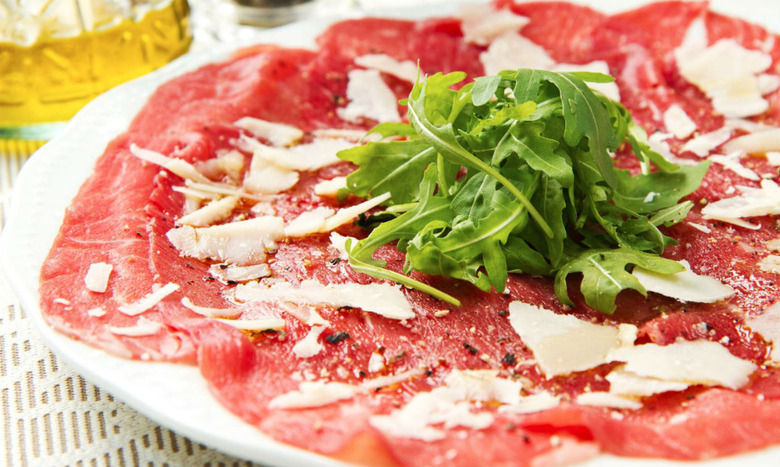What Do These Fancy Culinary Terms Actually Mean?
Navigating a fine-dining menu can be a challenging endeavor, especially if you don't speak French. Here are 10 challenging fine-dining terms you might encounter while out on the town, along with their definitions.
Amuse-Bouche
You know you're in for a high-end meal when a complimentary amuse-bouche arrives shortly after you sit down. This is traditionally a very small course — just one or two bites — that the chef sends to the table. It's a way for the chef to express his or her philosophy on food and to give diners a glimpse of the meal that they're about to experience. While it literally translates as something with which to amuse the mouth, the gesture is more about a warm welcome and way to wake up diners' taste buds.
Carpaccio
Typically very thin slices of raw beef topped with lemon, olive oil, Parmigiano-Reggiano, and arugula. Today, the term generally refers to any thin-sliced raw meat or seafood.
Consommé
This is a clear soup, made from a richly flavored stock. While it may look like a cup of broth, the process involved is actually very complicated: Ground meat, vegetables, tomatoes, and egg white are added to stock and allowed to simmer until all the impurities are brought to the surface. This is then simmered even longer, then filtered, skimmed, refrigerated, and skimmed again. It's usually served very hot and with garnishes ranging from sherry to shaped savory custards. Because of the lengthy process and the fact that more than a pound of meat can go into one eight-ounce serving, consommé is a dish usually reserved for only the very wealthy.
Coulis
A coulis is a thick sauce made from puréed and strained fruits or vegetables. Vegetable coulis are usually used on meat and vegetable dishes or as a base for soups and sauces, and fruit coulis are generally used on desserts. Raspberry coulis is quite popular.
Crème Fraîche
Like sour cream and yogurt, crème fraîche is cream that's been soured and thickened with bacterial culture. It's less sour, thinner, and higher in fat than traditional sour cream, however, and lends a smooth and creamy texture to both savory and sweet dishes. It adds a velvety note to soups, for example, and is also served cold alongside fruit and powdered sugar as a dessert.
Foie Gras
Foie gras is the liver of a goose or duck that's been specially fattened via force-feeding. It's rich and buttery when seared, and also shines as a mousse or pâté. The force-feeding has turned it into one of the most controversial foods in existence, but it's something that everybody should try at least once.
Gastrique
A gastrique is a sweet and sour flavoring for sauces traditionally made by deglazing caramelized sugar with vinegar and stock. Today, when you see the term gastrique on a menu it usually implies that the sauce will be tart and slightly sweet.
Hors d'Oeuvres
These small starter dishes are intended to be eaten by hand. They're usually passed around during the hour before dinner or during a cocktail party. A canapé (which translates to "couch") is a popular style of hors d'oeuvre: It's thinly-sliced bread (the couch) topped with anything from smoked salmon to foie gras.
Prix-Fixe
Also called a set menu, a prix-fixe is a multi-course menu that has a fixed price. The menu is often set in stone, but in some cases guests may choose between a handful of appetizers, entrées, and desserts.
Quenelle
The term quenelle has been turning up on many menus recently. In its strictest definition, it's a Lyonnaise dish in which creamed fish or meat (usually pike) is formed into a football shaped dumpling, which is then poached, broiled, and served in a cream sauce. While true quenelles are only found on the menu at the highest-end French restaurants, you'll see the term applied to other foods — especially ice cream, sorbet, and mashed potatoes — when served in a similar shape.
